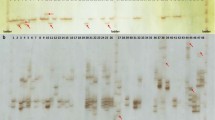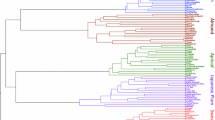Abstract.
We report the sequence of 41 primer pairs of microsatellites from a CT-enriched genomic library of the peach cultivar 'Merrill O'Henry'. Ten microsatellite-containing clones had sequences similar to plant coding sequences in databases and could be used as markers for known functions. For microsatellites segregating at least in one of the two Prunus F2 progenies analyzed, it was possible to demonstrate Mendelian inheritance. Microsatellite polymorphism was evaluated in 27 peach and 21 sweet cherry cultivars. All primer pairs gave PCR-amplification products on peach and 33 on cherry (80.5%). Six PCR-amplifications revealed several loci (14.6%) in peach and eight (19.5%) in sweet cherry. Among the 33 single-locus microsatellites amplified in peach and sweet cherry, 13 revealed polymorphism both in peach and cherry, 19 were polymorphic only on peach and one was polymorphic only on cherry. The number of alleles per locus ranged from 1 to 9 for peach and from 1 to 6 on sweet cherry with an average of 4.2 and 2.8 in peach and sweet cherry, respectively. Cross-species amplification was tested within the Prunus species: Prunus avium L. (sweet cherry and mazzard), Prunus cerasus L. (sour cherry), Prunus domestica L. (European plum), Prunus amygdalus Batsch. (almond), Prunus armeniaca L. (apricot), Prunus cerasifera Ehrh. (Myrobalan plum). Plants from other genera of the Rosaceae were also tested: Malus (apple) and Fragaria (strawberry), as well as species not belonging to the Rosaceae: Castanea (chestnut tree), Juglans (walnut tree) and Vitis (grapevine). Six microsatellites gave amplification on all the tested species. Among them, one had an amplified region homologous to sequences encoding a MADS-box protein in Malus × domestica. Twelve microsatellites (29.3%) were amplified in all the Rosaceae species tested and 31 (75.6%) were amplified in all the six Prunus species tested. Thirty three (80.5%), 18 (43.9%) and 13 (31.7%) gave amplification on chestnut tree, grapevine and walnut tree, respectively.
Similar content being viewed by others
Author information
Authors and Affiliations
Additional information
Electronic Publication
Rights and permissions
About this article
Cite this article
Dirlewanger, .E., Cosson, .P., Tavaud, .M. et al. Development of microsatellite markers in peach [Prunus persica (L.) Batsch] and their use in genetic diversity analysis in peach and sweet cherry (Prunus avium L.). Theor Appl Genet 105, 127–138 (2002). https://doi.org/10.1007/s00122-002-0867-7
Received:
Accepted:
Issue Date:
DOI: https://doi.org/10.1007/s00122-002-0867-7




